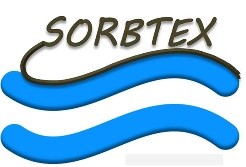Frequent oil spills and colored industrial effluents with high heavy metal ions content are seeking efficient, environmentally and economically feasible solution approaches. Although various sorbents for removal of such pollutants have been proposed, low efficiency, poor biodegradability and expensive industrial implementation make them insufficiently attractive for massive production. Nevertheless growing amounts of unexploited post-industrial and post-consumer textile waste are another burning environmental problem which calls for urgent solution. The innovative approach will addresses both environmental issues by recognizing the post-industrial jute waste as a resource and by applying the recycling as the one of the pillars of circular economy model in the production of non-woven sorbents. The potential application of differently constructed sorbents will be evaluated in three directions. The influence of sorbent construction, coating with fatty acids and carbonization on overall oil sorption properties necessary for efficient oil clean-up will be explored. For successful heavy metal ions uptake from water, sorbent will be coated with biopolymer alginate and nanocomposites comprising polyaniline and various nanomaterials (TiO2 nanotubes and nanoparticles, Fe3O4 nanoparticles and g-C3N4 nanosheets) and carbonized. Sorption and photodegradation of dyes from water will be provided by g-C3N4 nanosheets immobilized on the sorbent. The morphology and chemical changes of sorbents will be assessed by SEM, FTIR, XRD and Raman spectroscopy. Valorization of sorption efficacies will be performed by sets of standard tests. Taking into consideration that each modification should introduce to sorbent desired functionalities, the fabrication of sorbents with high capacities and good recovery are expected. Obtained results may initiate extensive research in this field, but they can also show high impact on national and regional strategies for utilization of textile waste.
Sustainable implementation of textile waste in treatment of polluted water
- Details
- Category: National projects archive
Acronym / code:
SORBTEX / 7673808


Project type:
IDEJE
Realization period:
20. 1. 2022 - 19. 1. 2025.
Project funded by:
Science Fund of the Republic of Serbia
SRO project holder:
Faculty of technology and metallurgy, University of Belgrade
- VINČA Institute of Nuclear Sciences, University of Belgrade
Principal investigator:
Prof Maja Radetić, Faculty of technology and metallurgy University of Belgrade
Project website:
https://www.sorbtex.org/index.html



